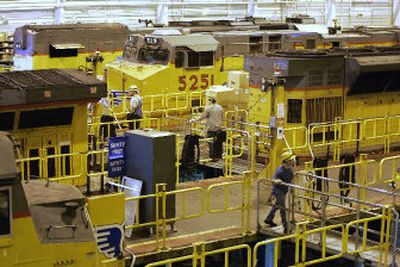They’re making tracks

NORTH PLATTE, Neb. — Something is almost always moving on the tightly packed 315 miles of railroad track here that the Guinness Book of World Records says is the world’s largest rail yard.
Four tracks lead into Union Pacific’s Bailey Yard from the west and four tracks leave the yard’s east side. In the eight miles between, the rails fan out to more than 150 tracks.
At night, lights bright enough to be noticed by astronauts in space illuminate the yard, so the work can continue.
“We don’t shut down for anything,” said David Thalken, who runs the locomotive repair shop.
Thalken’s attitude reflects pressure the yard faces to keep trains moving to satisfy increasing demand, fueled in part by Wyoming’s coal boom.
Rail yard workers use two hills, called “humps,” and some of those tracks to break apart some of the roughly 150 trains that pass through every 24 hours. Using the slopes’ gravity, crews sort cars into new groups bound for the same destinations, and hook the cars together to form new trains.
Other tracks are reserved for trains passing straight through the yard, like those teeming with Wyoming coal, yet those trains and locomotives need to be serviced and repaired.
But every minute that a train spends sitting in the North Platte rail yard — which the industry calls dwell time — costs Omaha-based Union Pacific Corp. money and limits how much cargo the nation’s largest railroad can transport.
That’s why Cameron Scott, who oversees the North Platte rail yard and Union Pacific’s operations from Marysville, Kan., to eastern Wyoming, spends so much time trying to speed up the train traffic through the rail yard.
Union Pacific’s average dwell time this year has been about 28.3 hours systemwide, which the railroad has reduced in recent years. But Union Pacific’s dwell time remains three to four hours higher on average than the nation’s second-largest railroad, Burlington Northern Santa Fe, according to industry analyst Donald Broughton of A.G. Edwards & Sons.
“There is a direct relationship between dwell time and operating margin,” Broughton said. “It’s a measure of how efficient you are.”
Even the trains passing straight through the North Platte rail yard spend about three hours there while the locomotives receive full tanks of diesel fuel and routine maintenance is performed.
Union Pacific is trying to shave more time off that process.
About a year ago, the rail yard developed five-man teams, inspired by NASCAR pit crews, to handle the maintenance tasks on trains passing straight through the yard.
Now two teams of five rotate between the eight run-through tracks providing what Scott calls express lube type service to locomotives by providing fuel, oil, sand and ice and checking the electrical system.
For empty coal trains returning to the mines, the North Platte rail yard started a program last year to identify and repair the trains with the most problem cars. Scott said sensors along the tracks can determine when wheels are bad and bearings are failing by the sounds they make.
Those trains with the most problems are pulled out of circulation for two days of intensive repair and maintenance work.
For empty coal trains with just a few bad cars, there are two options.
The standard practice has been to remove the cars for repairs and replace them.
About 900 coal cars sit in a spare yard at North Platte waiting to be attached to coal trains headed to the mines in Wyoming as needed. Like nearly all Union Pacific coal cars on the rails, those spares are owned by utilities and not the railroad.
The second option, which Scott said started this past summer, is to repair the cars without removing them from the train.
This concept is appealing, Scott said, because finding matching spare cars and hooking them up to a train is time consuming. On average, westbound coal trains spend a little more than seven hours in the rail yard because more repairs are done on the empty trains.
Union Pacific is also trying to make sure enough empty coal trains reach the Wyoming mines every day, so deliveries can continue as promised.
“It’s all about staying ahead of these coal guys, and all the business they’re trying to bring in,” Scott said.
Union Pacific is investing about $25 million in North Platte to add a third main line through the heart of the rail yard that should be ready by November.